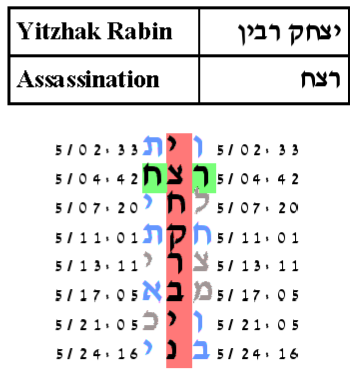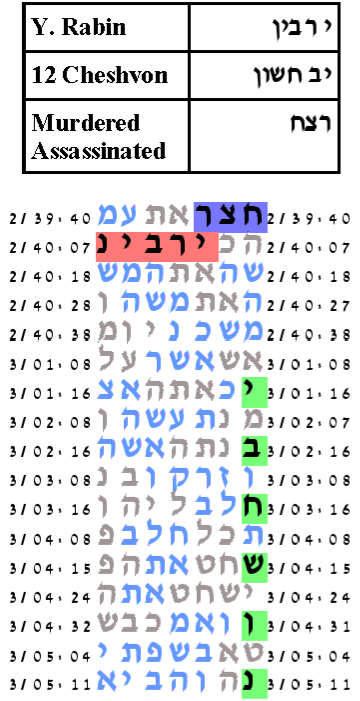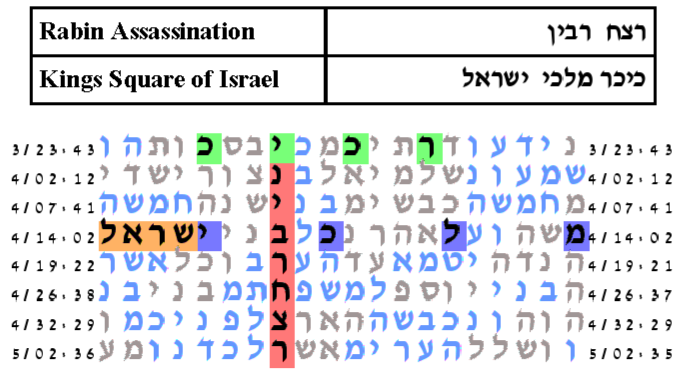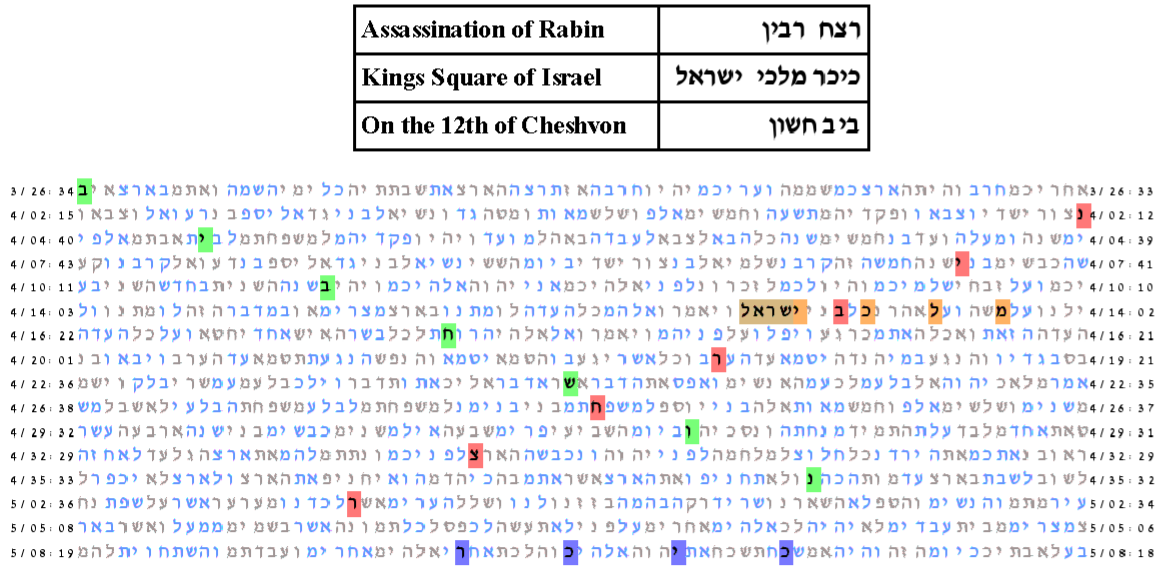| Home» The Rabin Assassination |
The Rabin Assassination
The basic description of the event is exactly the way we title the section: Rabin Assassination. For Rabin's appellation we use four forms: Rabin, Y. Rabin, Yitzhak Rabin, and Yitzhak-Rabin. This makes for a total of four subexperiments. The best subexperiment used the appellation Yizhak-Rabin. With expected number of ELSs set to 10, the probability that a text from the ELS random placement text population would produce as compact a table as the Torah text is 34.5/10,000. Combining the results of the four subexperiments for a single score in our standard way for each trial, the probability that a text from the ELS random placement text population would produce as good as a result as the Torah text is 111/10,000.

The date of the Rabin assassination was the evening of November 4, 1995. November 4, 1995 corresponds to the Hebrew date of the 11th of Cheshvon. But the assassination was in the evening after sunset and so the corresponding Hebrew date is the 12th of Cheshvon. For our first characteristic description of the Rabin Assassination we group together the key words Rabin, 12 of Cheshvon, and Assassination. For the appellations for Rabin we use Rabin, Y. Rabin, Yitzhak Rabin, and Yitzhak-Rabin. For the date we use the standard three forms Cheshvon 12, 12th of Cheshvon, on Cheshvon 12. There are thus a total of 12 subexperiments. For the best combination of key words, with the expected number of ELSs set to 20, the probability that a text from the ELS random text population would have as compact a table as that produced by the Torah text is 22.5/1,000. Combining results in our standard way to obtain a score on a trial by trial basis, the probability that a text from the ELS random text population would produce as good a combined result as the Torah text is 221/1,000.

Next we repeat the previous experiment using the year 5756 in place of the month and date. We use the two forms: 5756 and (5)5756 and in addition to the four appellations for Rabin, we add one more key word: Rabin-Assassination. This makes for a total of 10 subexperiments. With expected number of ELSs set to 10, the probability that a text from the ELS random placement text population would produce as compact a table as that produced by the Torah text is 22.5/1,000. There are a total of 10 subexperiments. Using our standard methodology for combining results on a trial by trial basis, the probability that a text from the ELS random placement text population would produce as good as combined result as that produced by the Torah text is 199/1,000.

The place of the Rabin assassination was Kings Square of Israel in Tel Aviv. Thus we group together the key words for Rabin, Assassination, and Kings Square of Israel. For Rabin we use as before 4 appellations and in addition we make one possibility by combining assassination with Rabin, making for a total of 5 combinations. For each of these 5 combinations we have 3 combinations: Kings Square of Israel as three separate words, or as KingsSquare Israel or as Square KingsIsrael. This makes a total of 15 subexperiments and they are listed below.
| רבין | כיכר מלכי ישראל | רצח |
| רבין | כיכר מלכיישראל | רצח |
| רבין | כיכרמלכי ישראל | רצח |
| ירבין | כיכר מלכי ישראל | רצח |
| ירבין | כיכר מלכיישראל | רצח |
| ירבין | כיכרמלכי ישראל | רצח |
| יצחק רבין | כיכר מלכי ישראל | רצח |
| יצחק רבין | כיכר מלכיישראל | רצח |
| יצחק רבין | כיכרמלכי ישראל | רצח |
| יצחקרבין | כיכר מלכי ישראל | רצח |
| יצחקרבין | כיכר מלכיישראל | רצח |
| יצחקרבין | כיכרמלכי ישראל | רצח |
| רצחרבין | כיכר מלכי ישראל | |
| רצחרבין | כיכר מלכיישראל | |
| רצחרבין | כיכרמלכי ישראל |
One produced statistically significant results. With expected number of ELSs set to 100, the probability that a text from the ELS random placement text population would produce as compact a table as that produced by the Torah text is 65.5/10,000. Using our standard methodology for combining the 15 results to produce a single score on a trial by trial basis, the probability that a text from the ELS random placement text population would produce as good as a combined result as the Torah text is 653/10,000.

We tried an experiment in which we used the year either specified as 5756 (5)756. As in the previous experiment, we used three groupings for Kings Square of Israel and we used the four appellations of Rabin. This makes for a total of 24 experiments. Here one experiment did produce a statistically signficant result. With expected number of ELSs set to 100, the probability that a text from the ELS random placement text population would produce as compact a table as that produced by the Torah text is 9.5/1,000. Using our standard methodology for combining the 24 results into a single score on a trial by trial basis, the probability that a text from the ELS random placement text population would produce as good as a combined result as the Torah text is 160.5/1,000.

For our last experiment in this series, we used the 4 appellations for Rabin plus the Rabin-Assassination appellation along with the 3 forms for the month and date. This makes a total of 15 subexperiments. One of the 15 experiments produced a statistically significant result. With the expected number of ELSs set to 50, the probability that a text from the ELS random placement text population would produce as compact a table as the Torah text is 14.5/10,000. Using our standard methodology for combining the 15 results into a single score on a trial by trial basis, the probability that a text from the ELS random placement text population would produce as good as a combined result as the Torah text is 200.5/10,000.

Our conclusion for the experiments shown on this page is that for the restricted key word choices we tried, the statistical evidence is certainly not strong that there is an encoding of the selected key word sets by themselves alone. Either that can mean that there is not encoding of these key word sets or that the experimental choice that we made is too limited and there are other key words that are encoded with them. In the following web pages we provide evidence that the experimental choices we made on this page were in fact too limited. When we added additional key words for the names of the various people who were involved, the statistical evidence indeed gets stronger.


 Documentaries and Tutorials
Documentaries and Tutorials